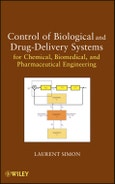Enables readers to apply process dynamics and control theory to solve bioprocess and drug delivery problems
The control of biological and drug delivery systems is critical to the health of millions of people worldwide. As a result, researchers in systems biology and drug delivery rely on process dynamics and control theory to build our knowledge of cell behavior and to develop more effective therapeutics, controlled release devices, and drug administration protocols to manage disease.
Written by a leading expert and educator in the field, this text helps readers develop a deep understanding of process dynamics and control theory in order to analyze and solve a broad range of problems in bioprocess and drug delivery systems. For example, readers will learn how stability criteria can be used to gain new insights into the regulation of biological pathways and lung mechanics. They'll also learn how the concept of a time constant is used to capture the dynamics of diffusive processes. Readers will also master such topics as external disturbances, transfer functions, and input/output models with the support of the author's clear explanations, as well as:
- Detailed examples from the biological sciences and novel drug delivery technologies
- 160 end-of-chapter problems with step-by-step solutions
- Demonstrations of how computational software such as MATLAB and Mathematica solve complex drug delivery problems
Control of Biological and Drug-Delivery Systems for Chemical, Biomedical, and Pharmaceutical Engineering is written primarily for undergraduate chemical and biomedical engineering students; however, it is also recommended for students and researchers in pharmaceutical engineering, process control, and systems biology. All readers will gain a new perspective on process dynamics and control theory that will enable them to develop new and better technologies and therapeutics to treat human disease.
Table of Contents
PREFACE xi
ACKNOWLEDGMENTS xv
1 INTRODUCTION 1
1.1 The Role of Process Dynamics and Control in Branches of Biology 1
1.2 The Role of Process Dynamics and Control in Drug-Delivery Systems 10
1.3 Instrumentation 12
1.4 Summary 18
Problems 18
References 19
2 MATHEMATICAL MODELS 21
2.1 Background 22
2.2 Dynamics of Bioreactors 27
2.3 One- and Two-Compartment Models 34
2.4 Enzyme Kinetics 37
2.5 Summary 39
Problems 39
References 41
3 LINEARIZATION AND DEVIATION VARIABLES 43
3.1 Computer Simulations 43
3.2 Linearization of Systems 44
3.3 Glycolytic Oscillation 55
3.4 Hodgkin–Huxley Model 57
3.5 Summary 60
Problems 61
References 63
4 STABILITY CONSIDERATIONS 65
4.1 Definition of Stability 65
4.2 Steady-State Conditions and Equilibrium Points 79
4.3 Phase-Plane Diagrams 80
4.4 Population Kinetics 80
4.5 Dynamics of Bioreactors 83
4.6 Glycolytic Oscillation 85
4.7 Hodgkin–Huxley Model 87
4.8 Summary 88
Problems 88
References 91
5 LAPLACE TRANSFORMS 93
5.1 Definition of Laplace Transforms 93
5.2 Properties of Laplace Transforms 95
5.3 Laplace Transforms of Functions, Derivatives, and Integrals 96
5.4 Laplace Transforms of Linear Ordinary Differential Equation (ODE) and Partial Differential Equation (PDE) 104
5.5 Continuous Fermentation 108
5.6 Two-Compartment Models 110
5.7 Gene Regulation 111
5.8 Summary 113
Problems 113
Reference 115
6 INVERSE LAPLACE TRANSFORMS 117
6.1 Heaviside Expansions 117
6.2 Residue Theorem 126
6.3 Continuous Fermentation 134
6.4 Degradation of Plasmid DNA 136
6.5 Constant-Rate Intravenous Infusion 138
6.6 Transdermal Drug-Delivery Systems 139
6.7 Summary 146
Problems 146
References 148
7 TRANSFER FUNCTIONS 149
7.1 Input–Output Models 149
7.2 Derivation of Transfer Functions 150
7.3 One- and Two-Compartment Models:
Michaelis–Menten Kinetics 154
7.4 Controlled-Release Systems 157
7.5 Summary 158
Problems 158
8 DYNAMIC BEHAVIORS OF TYPICAL PLANTS 163
8.1 First-, Second- and Higher-Order Systems 163
8.2 Reduced-Order Models 167
8.3 Transcendental Transfer Functions 169
8.4 Time Responses of Systems with Rational Transfer Functions 171
8.5 Time Responses of Systems with Transcendental Transfer Functions 190
8.6 Bone Regeneration 192
8.7 Nitric Oxide Transport to Pulmonary Arterioles 193
8.8 Transdermal Drug Delivery 194
8.9 Summary 194
Problems 195
References 197
9 CLOSED-LOOP RESPONSES WITH P, PI, AND PID CONTROLLERS 199
9.1 Block Diagram of Closed-Loop Systems 200
9.2 Proportional Control 203
9.3 PI Control 204
9.4 PID Control 206
9.5 Total Sugar Concentration in a Glutamic Acid Production 207
9.6 Temperature Control of Fermentations 209
9.7 DO Concentration 213
9.8 Summary 214
Problems 215
References 217
10 FREQUENCY RESPONSE ANALYSIS 219
10.1 Frequency Response for Linear Systems 219
10.2 Bode Diagrams 227
10.3 Nyquist Plots 229
10.4 Transdermal Drug Delivery 232
10.5 Compartmental Models 236
10.6 Summary 239
Problems 239
References 240
11 STABILITY ANALYSIS OF FEEDBACK SYSTEMS 243
11.1 Routh–Hurwitz Stability Criterion 243
11.2 Root Locus Analysis 248
11.3 Bode Stability Criterion 249
11.4 Nyquist Stability Criterion 254
11.5 Cheyne–Stokes Respiration 257
11.6 Regulation of Biological Pathways 262
11.7 Pupillary Light Reflex 264
11.8 Summary 265
Problems 265
References 267
12 DESIGN OF FEEDBACK CONTROLLERS 269
12.1 Tuning Methods for Feedback Controllers 269
12.2 Regulation of Glycemia 279
12.3 Dissolved Oxygen Concentration 282
12.4 Control of Biomass in a Chemostat 284
12.5 Controlled Infusion of Vasoactive Drugs 285
12.6 Bone Regeneration 286
12.7 Fed-Batch Biochemical Processes 288
12.8 Summary 289
Problems 289
References 291
13 FEEDBACK CONTROL OF DEAD-TIME SYSTEMS 293
13.1 Smith Predictor-Based Methods 294
13.2 Control of Biomass 300
13.3 Zymomonas mobilis Fermentation for Ethanol Production 302
13.4 Fed-Batch Cultivation of Acinetobacter calcoaceticus RAG-1 304
13.5 Regulation of Glycemia 304
13.6 Summary 306
Problems 306
References 309
14 CASCADE AND FEEDFORWARD CONTROL STRATEGIES 311
14.1 Cascade Control 311
14.2 Feedforward Control 317
14.3 Insulin Infusion 321
14.4 A Gaze Control System 323
14.5 Control of pH 326
14.6 Summary 330
Problems 331
References 333
15 EFFECTIVE TIME CONSTANT 335
15.1 Linear Second-Order ODEs 335
15.2 Sturm–Liouville (SL) Eigenvalue Problems 337
15.3 Relaxation Time Constant 340
15.4 Implementation in Mathematica® 342
15.5 Controlled-Release Devices 342
15.6 Summary 343
Problems 344
References 345
16 OPTIMUM CONTROL AND DESIGN 347
16.1 Orthogonal Collocation Techniques 348
16.2 Dynamic Programming 350
16.3 Optimal Control of Drug-Delivery Rates 350
16.4 Optimal Design of Controlled-Release Devices 351
16.5 Implementation in Mathematica® 352
16.6 Summary 358
Problems 359
References 360
INDEX 361








